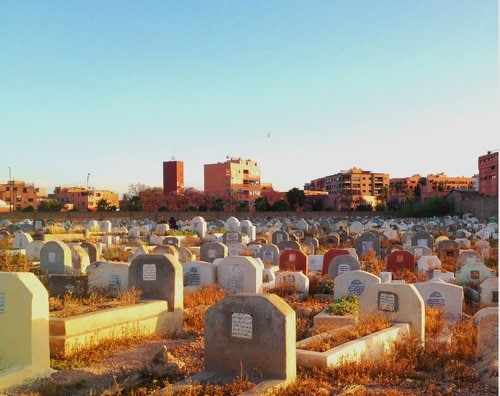Islamic Rules For a Cemetery. (Shafi’i)
Shafi'i Fiqh
Answered by Shaykh Jamir Meah
Question: Assalamu alaykum
In our city the government is giving us a place for an Islamic cemetary. I am involved in this project. The government asked us to note down the Islamic rules of a cemetery (for example Facing qibla). Could you kindly explain to us what the rules are for the Islamic cemetery according to the 4 schools?
Answer: Wa’alaykum assalam, thank you for your question. I’m happy to hear that your government has allocated land for a formal Muslim cemetery.
What is necessary to know in regards cemeteries is the following:
1. Muslims should be buried in their own area.
2. Optimally, the graves should be dug deep enough that an adult man could stand in it with his arms raised upwards, and wide enough for the body to be comfortably placed in it. The minimum is that it conceals the odour of the body and that the body is protected from being dug up by animals.
3. The deceased must be placed facing the direction of the Qibla. It is sunna to lie the body on the right side for this.
4. It is unlawful to bury someone where another person is buried unless the previous person’s remains have completely disintegrated, including the bones, unless out of absolute necessity. This will be an issue according to the law you mentioned, as a body would take much longer to dissolve than 20 years and depends on the soil.
What I would suggest is your community first speak to the relevant legal authorities and seek religious dispensation to extend the period in which graves are removed. Also, depending on the size of the land, planning should be made to utilise as much burial space as is possible, without cramping.
If these are not an option and later on it becomes clear that there is a shortage of burial spaces, and no further land has been designated for Muslim burials (perhaps later, the community can put this forward to government), then this may be considered a ‘necessity’, in which case, the bones should not be removed, but as you mentioned, should be put aside.
If the bones are put aside, all measures should be taken to ensure that males are placed in graves where a male is buried, and females where a female is buried, where possible. A barrier should be put up between the old bones and the new body.
If it later becomes absolutely necessary to put a man in grave where a female is buried and vice versa, then where possible, one should try to put the new body in a grave where one of their male/female mehram are buried. In these cases, where two people of the opposite gender are in the same grave, then placing a barrier in between the old bones and the new body is imperative.
[Tuhfatul Muhtaj, Umdat al Salik, Bushra al Karim]
And Allah knows best.
Warmest salams,
[Shaykh] Jamir Meah
Shaykh Jamir Meah grew up in Hampstead, London. In 2007, he traveled to Tarim, Yemen, where he spent nine years studying the Islamic sciences on a one-to-one basis under the foremost scholars of the Ribaat, Tarim, with a main specialization and focus on Shafi’i fiqh. In early 2016, he moved to Amman, Jordan, where he continues advanced studies in a range of Islamic sciences, as well as teaching. Jamir is a qualified homeopath.
